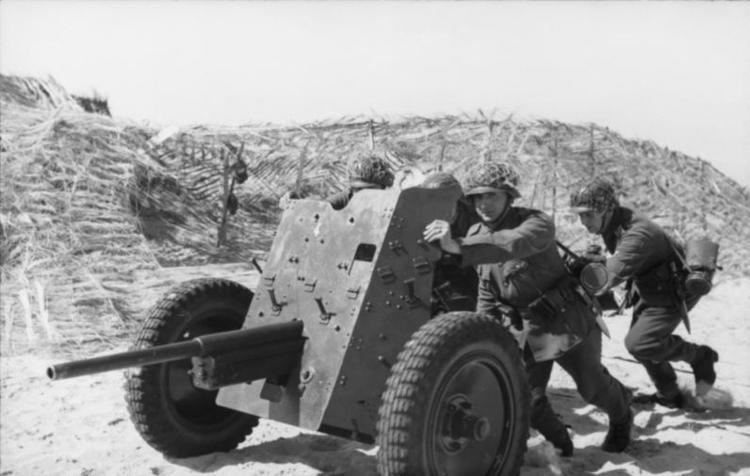Type Anti-tank gun Designer Rheinmetall | Place of origin Nazi Germany Manufacturer Rheinmetall | |
 | ||
Used by Nazi Germany
Kingdom of Italy
Republic of China
Finland
Estonia
Hungary
Slovakia
Kingdom of Romania Wars Second Sino-Japanese War
Spanish Civil War
World War II | ||
The Pak 36 (Panzerabwehrkanone 36) was a 3.7 cm calibre German anti-tank gun used during the Second World War. It was the main anti-tank weapon of Wehrmacht infantry units until mid-1941. It was followed in this role by the 5 cm Pak 38 anti-tank gun.
Contents
History
Design of a horse-drawn, 3.7 cm anti-tank gun (designated 3.7 cm Pak L/45) by Rheinmetall commenced in 1924 and the first guns were issued in 1928. By the early 1930s, it was apparent that horse-drawn artillery was obsolescent, and the gun was modified for motorized transport by substituting magnesium-alloy wheels and pneumatic tyres for the original spoked wooden wheels. Re-designated the 3.7 cm Pak 35/36, it began to replace the 3.7 cm Pak L/45 in 1934 and first appeared in combat in 1936 during the Spanish Civil War. It formed the basis for many other nations' anti-tank guns during the first years of World War II. The KwK 36 L/45 was the same gun, but used as the main armament on several tanks, most notably the early models of the Panzer III. The Soviets used the Pak 36 carriage design for their 45 mm M1937 AT gun.
Operational history
During the May 1940 Western Campaign, the Pak 36, being a relatively small-calibre weapon, was found to be inadequate against heavy Allied tanks like the British Mk II Matilda and the French Char B1 and Somua S35. Still, the gun was effective against the most common light tanks of the era, such as the French R35, whereas the Char Bs and Matildas represented but a small fraction of the total number of armoured vehicles during the Battle of France.
In June 1941, Soviet tank forces consisted of 10,661 T-26, 2,987 T-37/T-38/T-40/T-50s, 59 T-35, 442 T-28, 7,659 BT, 957 T-34, and 530 KVs for a combined total of approximately 23,295 tanks. Thus, during the initial phases of Operation Barbarossa, the Pak 36 could still penetrate the armour of the majority of Soviet AFVs at ranges up to 1000 m from the front, with the notable exception of the T-28s and T-35s, which it could penetrate only at under 100 m; the Pak 36 could not penetrate the relatively thick armour of the T-34s and KV-1s. By late 1941, the widespread introduction of the T-34 on the Eastern Front made the Pak 36 obsolete, considering its miserable performance against it. This led to the Pak 36 being nicknamed Heeresanklopfgerät (literally "army door-knocking device") by German anti-tank crews for its inability to affect the T-34 aside from notifying its presence by futilely bouncing rounds off its armour, regardless of the angle or distance.
The addition of tungsten-core shells (Pzgr. 40) slightly improved the armour penetration of the Pak 36, enabling it to finally damage the T-34, but only via a direct shot to the rear or side armour from point-blank range; an unlikely and dangerous scenario. However, despite its continued impotence against the T-34, it remained the standard anti-tank weapon for many units until 1942. The advantages of the Pak 36 were its; relative ease of handling and mobility (it could be brought into action very rapidly by as few as two men since it weighed only 432 kg); good quality optics/aiming devices; ease of concealment due to its small size; and high rate of fire.
The Pak 36 began to be replaced by the new 5 cm Pak 38 in mid-1941. As it was gradually replaced, many were removed from their carriages and added to SdKfz 251 halftracks for use as light anti-armour support. The guns were also passed off to the forces of Germany's allies fighting on the Eastern Front, such as the 3rd and 4th Romanian Army. This proved particularly disastrous during the Soviet encirclement (Operation Uranus) at the Battle of Stalingrad when the Romanian forces, already demoralized and understrength, bore the brunt of the main Soviet armored thrust and were unable to stop the Soviet advances due to their grossly inadequate anti-tank weaponry. The Pak 36 also served with the armies of Italy, Finland, Hungary, and Slovakia.
Although the Pak 36 quickly became ineffectual in the European and Russian theatres, in China the gun was still viable as an effective anti-tank gun. It could destroy the Japanese Type 95 Ha-Go and Type 97 Chi-Ha tanks, since their armour protection was quite weak. For example, during the Battle of Taierzhuang, Chinese Pak 36s destroyed a good number of Japanese tanks.
3.7 cm Pak 36 L/45 ammunition
This was a type of tungsten-core ammunition, being lighter and with a higher muzzle velocity, produced in small quantities.
Penetration figures given for Pzgr 40 and an armoured plate 30 degrees from the horizontal.
Stielgranate 41
In 1943, the introduction of the Stielgranate 41 shaped charge meant that the Pak 36 could now penetrate most armour, although the low velocity of the projectile limited its range. The Pak 36s, together with the new shaped charges, were issued to Fallschirmjäger units and other lightly equipped troops. The gun's low weight meant that it could be easily moved by hand, and this mobility made it ideal for their purpose.
